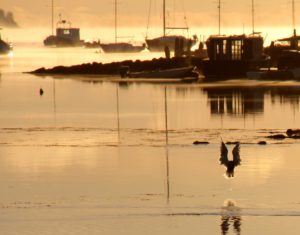With ALICE BURDICK

Your name: Alice Burdick
Current city or town: Mahone Bay, Nova Scotia
How long have you lived here: I’ve lived in Mahone Bay since 2008, so eight years, and just outside Lunenburg for five years before that. I moved to Halifax in 2002 and lived there for around a year, after growing up in Toronto and mainly living there, but also in Espanola Ontario and British Columbia—in Vancouver and near Roberts Creek.
Three words to describe the climate: Temperate, coastal, breezy.
Best time of year to visit? I love autumn the most here, but summer is also glorious. Autumn is quieter tourist-wise, but the weather’s still gorgeous, and the insects that bite aren’t around (except for the ticks in tall grass). Also the ocean water is more swimmable than in the summer! September to early-mid October are excellent.
1) The most striking physical features of this city/town are . . .
Mahone Bay is known for the “three churches.” Those are just the three churches in a row, but there are five in total, and who knows what’s going on in people’s basements. For a town of 900 people (in the summer), that’s a lot of options. They probably were a real comfort for those on the water for long periods of time.
The streets are arranged like a wedge of pie with the crust at the shore, along the water, where the main street is, which is called Main Street. This is where there are shops and docks for boats. There’s a lovely former railbed that is now a trail—and I wonder if it was actually a trail before it was a railroad, full circle— and it’s rich with animals and great to walk or bike. Also lots of gentle hills called drumlins, formed from glacial action (not recent).
2) The stereotype of the people who live here and what this stereotype misses . .
I’m not sure what the stereotype is, but it’s a small town, and a Maritime town, so there may be city-folk who find country-folk quaint. Any idea of quaintness is wrong, but sometimes also perpetuated by people who live here, for monetary or other reasons. Mahone Bay is a tiny town but it has a good cross section of people who’ve been born and raised here; those who’ve moved here from elsewhere in Canada, the US, or Europe; and families and retirees. It is a very white place, which reflects how Mi’kmaq in the area were “moved on,” rather than a mysterious void in the land that was filled by European settlers.
3) Historical context in broad strokes and the moments in which you feel this history. . .
Mahone Bay—the body of water—was named after a mahonne, a French barge used by privateers (legally sanctioned pirates). It was formerly Mushamush, also a river that flows into the bay. Shipbuilding was a major industry here, and there was a housing boom in the mid to late 1800s so there are quite a few large, slightly pompous houses with gingerbread ornamentation. You do get a sense of oneupmanship in the town, where people built larger and larger to show their prosperity. This is entertaining. There is a certain sort of nostalgia that is encouraged by locals in aid of tourism (see quaintness, above). There are also quite a few buildings still standing that served as the buildings where ships were made, as well as barns—which remind the person walking through the streets that people kept their own animals and that there were farms sometimes two blocks up from the harbour. The last house I lived in in Mahone Bay was a former farmhouse, and I talked with some guys who remembered going there to get fresh milk.
4) Common jobs and industries and the effect on the town/city’s personality. . .
Mahone Bay is definitely a tourist town—that is where it makes its bread and butter. So there are a lot of small businesses, including a good number of food places and gift shops. There is also a plastics plant that employs 200 people, and is studiously ignored by photographers taking pictures of everything else in town. It is a year-round employer that provides more jobs than any one of the tourism-related shops in town but it is an embarrassment to those who want to emphasize historical houses, etc. There is an undercurrent of classism here related also to the fact that often you are either a person who has to work a lot, and work multiple jobs, or you are a retiree who would like to live without thinking about these things. Lots of people have to work multiple jobs to stay afloat, in the service industries particularly. Most of the small gift shops close down for months from October to May, so that affects employment patterns. There are also a number of self-employed artists and business people who live here.
5) Local/regional vocabulary or food?
Sauerkraut is big here. Not in Mahone Bay proper, but the South Shore in general, which reflects the German Protestant influence. In fact, there is a Krispy Kraut sauerkraut factory, one of the best names of anything anywhere. And pretty good sauerkraut!
Sometimes people inhale “yup, yup, yup” to indicate sympathy, acknowledgement, that they’re listening. There are lots of other quirks of phrasing and pronunciation that are peculiar to the area.
Alice Burdick‘s most recent book of poetry is Book of Short Sentences (Mansfield Press).
Photo by Nancy McCarthy.



